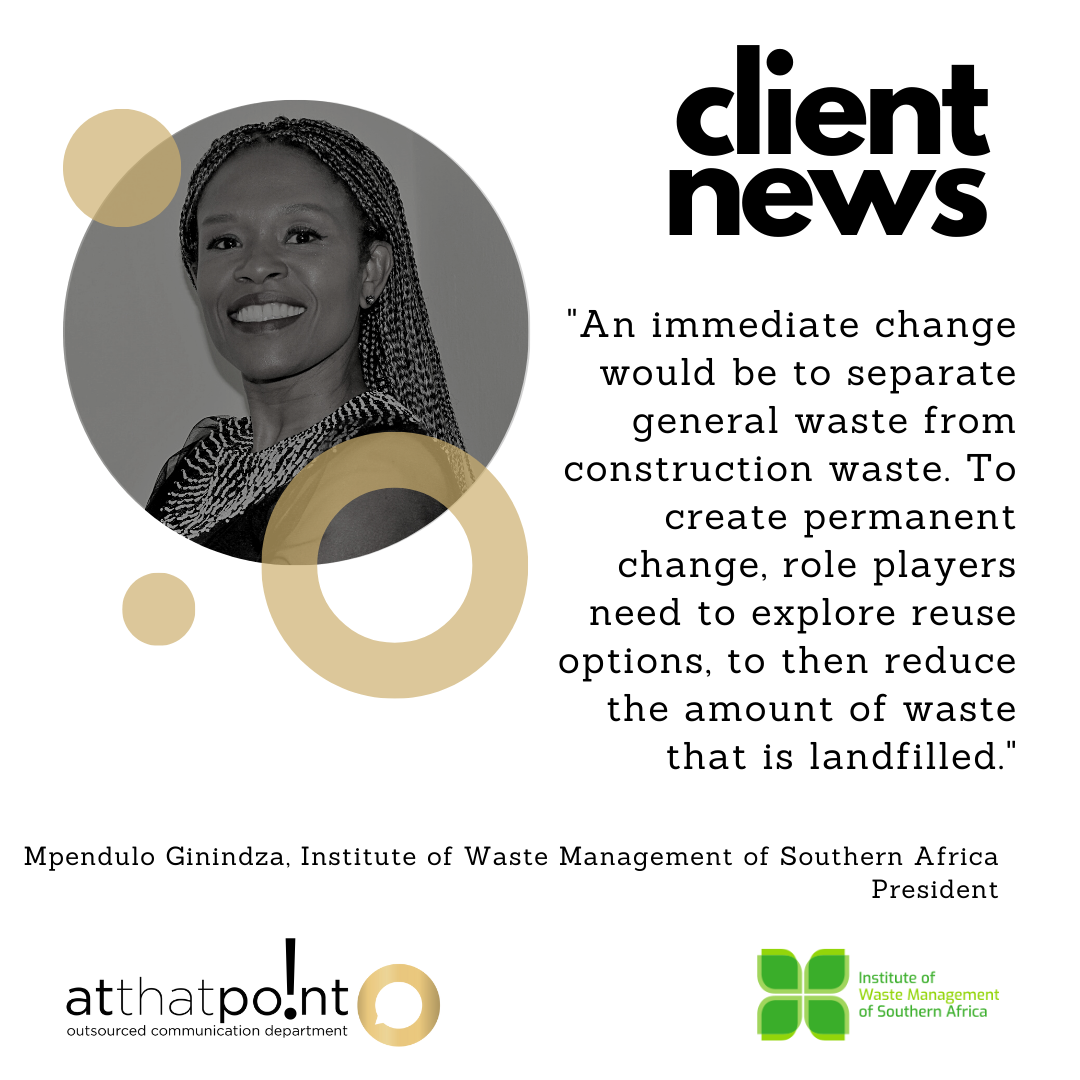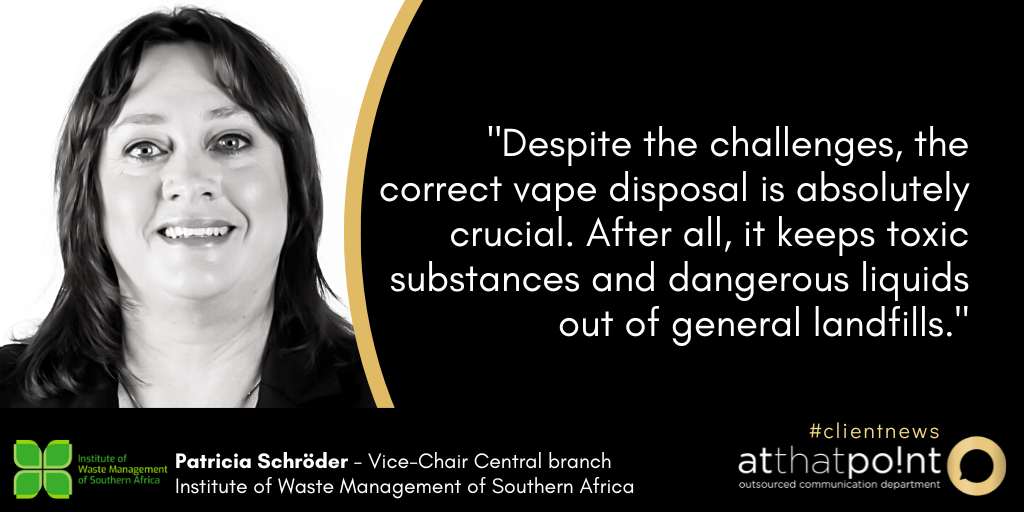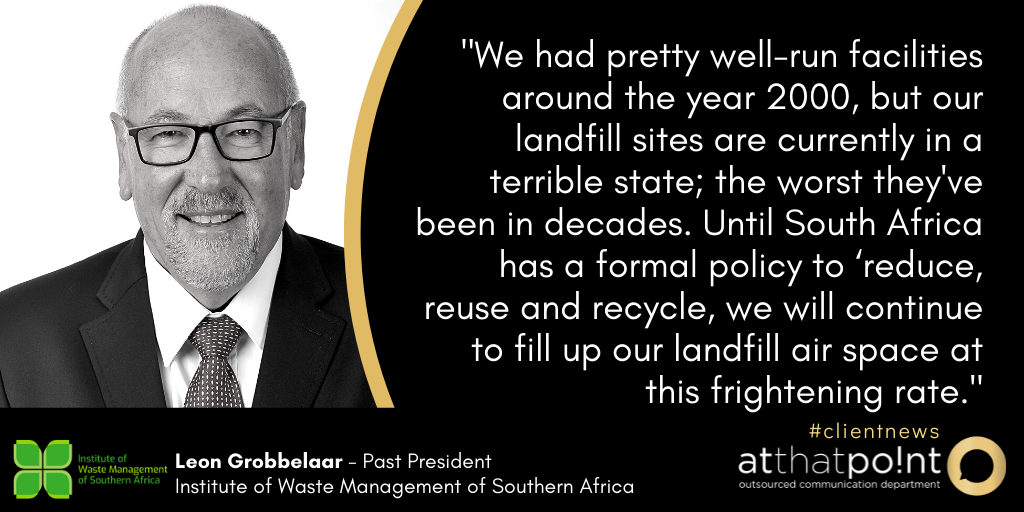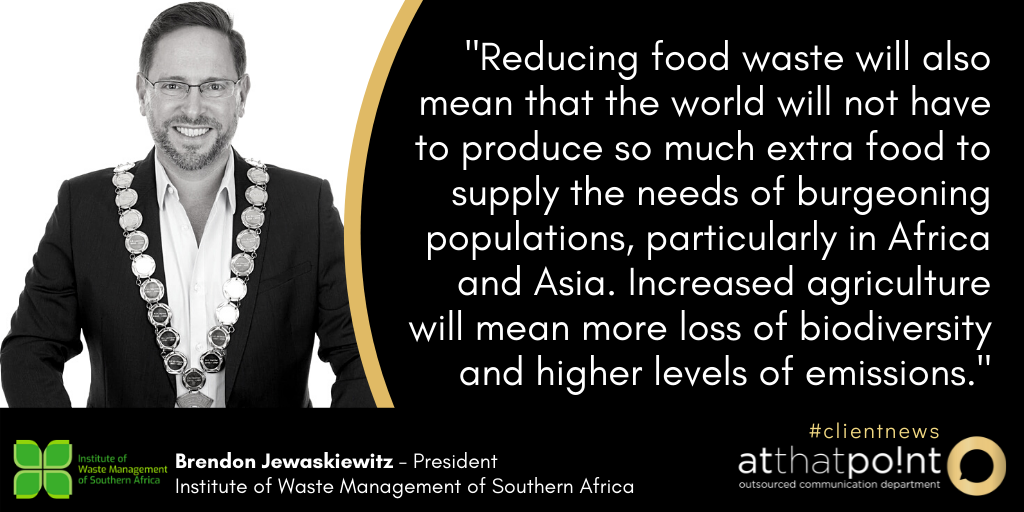 June 5 is World Environment Day and this year’s theme is Land Restoration, Desertification & Drought Resilience. “These concerns are of the utmost importance to South Africa because the country is greatly susceptible to all three,” says Leon Grobbelaar, past President of the Institute of Waste Management of Southern Africa (IWMSA). He asserts that good waste management plays a pivotal role in mitigating desertification and drought and facilitates land restoration. The South African landscape The World Economic Forum describes desertification as gradual degradation of the productive soil, water, biodiversity, and vegetation in an already arid landscape. The Department of Forestry, Fisheries and the Environment (DFFE)’s National Action Programme for South Africa to Combat Desertification, Land Degradation and the Effects of Drought (2018-2030) notes that 91% of the country is drylands, making it especially vulnerable to desertification. In addition, South Africa’s annual average rainfall is just 464mm, compared to the global average of 860mm per annum. Apart from its naturally dry climate, the country has suffered regular droughts over the last several decades. These geographic factors have been exacerbated by man-made problems, such as climate change, deforestation, overgrazing of livestock, and unsustainable agricultural practices. “Desertification, land degradation and drought inevitably endanger food security and water availability, negatively impacting the health, productivity and prosperity of our society,” says Grobbelaar. The role of waste management Waste management paves the way for land restoration and drought resilience by helping to preserve the existing condition of these resources. “It’s no good fighting to win back land and water if we continue contaminating them at the same time,” says Grobbelaar. This means directing waste away from fertile soil and sources of water to protect what remains and lay the foundation for the renewal of affected areas. The term “waste” covers a wide array of elements, from everyday household refuse to electronic devices, organic matter, chemicals, and even nuclear materials Waste should be seen as a resource and hence the promotion and implementation of the circular economy and cradle to cradle principles. Any number of these, discarded irresponsibly, threaten to contaminate soil and water, polluting the environment and the plant life, animals and humans that inhabit it. In addition, waste management practices, like commodity recovery practises and composting, can accelerate land restoration and drought resilience. For example, composted organic waste or processed faecal sludge can enrich soil, returning it to a productive state, while efficient water sanitation ensures that scarce, clean water is rapidly cycled back into lakes and rivers. Innovating for the future To ensure these outcomes, it’s critical that new and innovative waste management techniques and technologies be implemented to keep pace with future needs. For example, the use of landfills as primary disposal option is not sustainable and alternative treatment and recovery solutions must be enforced and implemented. “We need new approaches, and the waste community continues to research more efficient methods and means to overcome current limitations,” says Grobbelaar. It’s appropriate that World Environment Day takes place in June, which is also Youth Month, because much of this innovation will come from a new generation of waste management professionals. The IWMSA recognises and fosters these new perspectives through its Young Professionals Group (YPG) in the hope of accelerating current programmes in the industry. “We have no doubt that they will contribute to a lusher, greener South Africa that promises health and happiness to all our citizens,” says Grobbelaar. ENDS MEDIA CONTACT: Idele Prinsloo,[email protected], 082 573 9219, www.atthatpoint.co.za For more information on IWMSA please visit: Website: Home (iwmsa.co.za) X: @IWMSA LinkedIn: Institute of Waste Management of Southern Africa Facebook: Institute of Waste Management of Southern Africa
0 Comments
 This World Earth Day April 22, 2024, the Institute of Waste Management of Southern Africa (IWMSA) underscores the critical need for concerted efforts to combat plastic pollution, a pressing environmental challenge in South Africa. This year's theme, "Planet vs. Plastics," resonates deeply with the ongoing battle against plastic pollution in our country, emphasising the urgency of transitioning towards sustainable waste management practices and reducing plastic production. According to Mpendulo Ginindza, President of the IWMSA, "The plastic economy in South Africa is based on a linear model of take-make-waste, leading to significant environmental consequences. Improper waste management results in plastic waste infiltrating our rivers, oceans, and communities, posing threats to wildlife and ecosystems.” She says that even seemingly sustainable solutions need to be rethought when it comes to how we handle waste management. According to the Ewastemonitorinfo.org’s new report, The global E-waste Monitor 2024, the green transition and the connecting of off-grid communities will lead to a quadrupling of waste from photovoltaic panels from 0.6 billion kg in 2022 to 2.4 billion kg in 2030. “Small equipment, such as video cameras, toys, microwave ovens and e-cigarettes, also constitutes the largest category of e-waste in terms of mass, accounting for 20 billion kg in 2022, or almost one-third of the world’s total e-waste,” says Ginindza. In alignment with World Earth Day's "Planet vs. Plastics" theme, the IWMSA is devoted to raising awareness about the detrimental impacts of plastic pollution and promoting sustainable solutions to address this pressing issue. Through initiatives such as community clean-ups and educational campaigns, the IWMSA aims to empower individuals, businesses, and government agencies to take proactive steps towards reducing plastic consumption and promoting a circular economy. "We have industry experts working tirelessly to review and update our training programs, equipping our members with the knowledge and tools to promote a circular economy and reduce plastic production," says Ginindza. Collaboration Among Government Agencies, Businesses, and Individuals is needed The IWMSA acknowledges the importance of collaboration among government agencies, businesses, and individuals in tackling plastic pollution and promoting sustainable waste management practices. Through strategic partnerships and collaborative initiatives, the IWMSA wants to harness collective efforts towards achieving the ambitious goal of reducing plastic production by 60% by 2040. “As a member driven organisation, we require participation of members so that we can effectively engage stakeholders. IWMSA has MOUs with strategic partners, these include the DFFE, various universities and NGOs, and industries that support our vision. If we are to achieve the 2040 targets, we must work together. It requires collaboration and participation,” says Ginindza. Despite facing challenges in achieving this target, including the need for increased member participation and stakeholder engagement, the IWMSA remains steadfast in its commitment to driving progress towards a sustainable future. Success stories, such as the development of professionals through IWMSA programs, underscore the organisation's impact in promoting environmental stewardship and responsible waste management practices. Building on this commitment, the International Solid Waste Association (ISWA), played a key role at the first session of the Intergovernmental Negotiating Committee (INC-1) on Plastic Pollution. The meeting, held in Punta del Este, Uruguay from November 28 to December 2, 2022, focused on addressing the severe issue of plastic pollution as part of a wider environmental crisis. During the session, ISWA engaged with various stakeholders and member states, advocating for the development of an international legally binding agreement to combat plastic pollution effectively. The IWMSA has shared ISWA’s recommendations with the Department of Forestry, Fisheries and the Environment who are the National Focal Point. ISWA’s contribution, crafted with insights from its Science and Technical Committee and finalised by a Task Force coordinating committee, is now available on the United Nations Environment Programme website. Consumer Education and Empowerment Key to Fostering Sustainable Consumption Habits As consumers play a crucial role in addressing the plastic pollution crisis, the IWMSA emphasises the importance of consumer education and empowerment in fostering sustainable consumption habits. By making informed choices and supporting initiatives that promote waste management and recycling, individuals can contribute to the shift towards a circular economy. “Looking ahead, the IWMSA's priorities include advancing its mission of promoting responsible waste management and environmental stewardship in South Africa, with a focus on driving the transition towards a circular economy and creating value from secondary resources to support job creation and economic growth,” concludes Ginindza. ENDS MEDIA CONTACT: Idele Prinsloo, [email protected], 082 573 9219 www.atthatpoint.co.za For more information on IWMSA please visit: Website: Home (iwmsa.co.za) X: @IWMSA LinkedIn: Institute of Waste Management of Southern Africa Facebook: Institute of Waste Management of Southern Africa  Whether you're a corporate event planner or a parent hosting a family party this Easter Weekend, you'll probably have your hands full with planning and preparations. "This year, it's equally important to work waste management into your do," says Mpendulo Ginindza, President of the Institute of Waste Management of Southern Africa (IWMSA). Countrywide Easter events can put a huge strain on the national waste management infrastructure and that's bad news for the environment. So, let’s commit to doing things differently this time around. Planning a Zero Waste event Planning for waste management means having the right mindset. You can be a waste-free event pro by following these guidelines from Mpendulo:
Extra tips
This Easter bash is going to be your best one yet, all because of your waste management skills. That's extra cause for celebration. "The IWMSA thanks you for your efforts and wishes all South Africans a happy, safe and waste-free Easter," says Mpendulo. ENDS MEDIA CONTACT: Idele Prinsloo, [email protected], 082 573 9219, www.atthatpoint.co.za For more information on IWMSA please visit: Website: Home (iwmsa.co.za) Twitter: @IWMSA LinkedIn: Institute of Waste Management of Southern Africa Facebook: Institute of Waste Management of Southern Africa Every industry suffers its fair share of myths, and waste management is no different.
"We need to separate the truth from the half-truths and nonsense that can hinder our progress towards a waste-free society," says Mpendulo Ginindza, President of the Institute of Waste Management of Southern Africa. Here are her 10 top myths about waste management. Myth 1: Waste Management is only about garbage disposal How to dispose of one's garbage is just a small part of waste management, a complex discipline that reaches across industries and national borders. It embraces strategies for ethical, sustainable and responsible product development, manufacture, consumption and disposal, including the destruction, storage, recycling or reusability of waste. Myth 2: Waste management is solely the government's responsibility Waste management is, in fact, the responsibility of everyone who generates waste, including households, retailers and, under recent legislation, product manufacturers. They are assisted by the waste managers who direct day-to-day operations in the waste industry. Myth 3: The goal of Waste Management is to save the environment While environmental preservation is a key goal of waste management, it equally benefits society and the economy. This includes protecting the health of humans, animals and plant life by preventing them and their surroundings from becoming contaminated. Contamination can threaten food and water supplies, and therefore has dire economic implications. Myth 4: Landfills are the only solution Until now, landfills have been a necessary evil, not a solution. Modern waste management comprises a range of alternative strategies that seek to reduce landfills and minimise our dependence on them. Myth 5: Recycling is too expensive and inefficient In some cases, maybe, but if this myth were really true, recycling companies would not survive long, let alone profit as they do. Every year, recycling technologies become more advanced, cost-effective and efficient, ensuring recycling remains a go-to waste management practice. Myth 6: Everything must be recycled Unfortunately, this myth is the result of retail marketing focusing only on recycling because the term is popular with consumers. In fact, not all waste is suitable for recycling and other methods exist to handle anything that is not. They include incineration, composting, waste-to-energy, reuse and others. Myth 7: We need to maximise recycling rates If only. However, achieving a maximum rate of recycling depends on many factors, such as recycling technologies, capabilities and throughput capacity as well as economic viability. Every solution has limits and, as mentioned, attention and resources must also be given to managing waste that cannot be recycled at all and for which better techniques exist. Myth 8: Stricter regulation is the answer Do more traffic cameras prevent people from speeding? Usually not. Regulation only sets the standard for compliance. It must be supported by education and public awareness programmes that teach people the benefits of positive waste management behaviours. Training needs to start at home and in kindergarten, and continue throughout high school, university and into employment. Myth 9: Waste Management is a secondary concern You may be surprised that many of today's global problems, especially the climate crisis, are directly or indirectly linked to poor waste management. It is actually a primary concern because it is deeply embedded in so many others. Myth 10: Third world countries can't afford waste management The truth? We cannot afford not to embrace waste management because that will cost us dearly in the long run. In fact, we have the opportunity to lead the world by developing advanced waste management techniques that fit the African context. Busting myths Successful waste management demands the participation of all stakeholders, including consumers, businesses, and government. Unfortunately, waste management myths can hamper our initiatives and hinder our progress. "We need to educate ourselves on waste management truths so we can develop effective strategies, and each play a meaningful role in reducing waste," says Ginindza. ENDS MEDIA CONTACT: Idele Prinsloo, [email protected], 082 573 9219, www.atthatpoint.co.za For more information on IWMSA please visit: Website: Home (iwmsa.co.za) X (Twitter): @IWMSA LinkedIn: Institute of Waste Management of Southern Africa Waste Management in 2024:South Africa’s Challenges, Goals, and the Road to a Circular Economy5/2/2024 Population growth, unfunded waste services, landfill airspace depletion, inadequate waste diversion and outdated infrastructure. These are but a few of the major challenges that the South African waste industry grapples with in 2024.
But Mpendulo Ginindza, President of the Institute of Waste Management of South Africa (IWMSA), says not all is lost and that many positive strides are being made towards achieving a circular economy by 2030. She adds that one of the biggest steps creating an enabling environment for change was the 2008 implementation of the NEM Waste Act. “The Act's focus was the waste management hierarchy, which encourages reducing waste to landfill,” she explains. “We have seen a flood of regulations in response to this. Needless to say, our legislation is amongst the best in the world. However, implementing and enforcing this legislation is our challenge.” The Challenges: Waste Minimisation and Public Awareness The issue of diminishing landfill airspace is one that South Africa continues to face - especially in major metros. Ginindza says Cape Town, eThekwini, and Ekurhuleni are already experiencing increases in the cost of moving waste as their landfills reach capacity. She adds that locally, the focus still falls too much on waste management with not enough attention given to actual waste minimisation. “In most cases the waste collection and disposal company provides that service, but yet it is not their core business,” Ginindza explains, adding that households are generally not ‘separating at source’, with waste pickers doing only some of that work. “Education and awareness also need to be driven in schools. This situation requires everyone’s involvement - from households to business.” Another area that the IWMSA believes can be improved is partnerships and collaborations. “South Africa must emphasise the need to develop capacity, not only locally, but also in the region. We miss out on funding opportunities, not because there is no need to fund projects, but because there is no capacity or capability.” The Successes: EPR Regulations and e-Waste Diversion Ginindza says partnerships between government and private sector are yielding results - such as Producer Responsibility Organisations (PROs) implementing and expanding programs for waste diversion. “Part of their role is to work with municipalities to build infrastructure for managing waste,” she adds. “Extended Producer Responsibility (EPR) regulations have also been implemented and producers are now responsible for the entire lifecycle of their products which includes their waste management. “And although EPR does not solve all the country’s waste management problems, it is a crucial tool. “In South Africa, EPR focuses on waste picker integration and circular economy. We should therefore acknowledge the role that waste pickers have played in waste diversion.” A lot of effort was also made to make people aware of the dangers of e-waste. “It is now restricted from being disposed of to landfill, with a Waste from Electrical and Electronic Equipment (WEEE) policy under development. It will provide guidance and help to drive proper disposal and recycling.” In conclusion, Ginindza says small businesses that want to make sure they comply, can reach out to the IWMSA. “We provide support through our training programmes and engaging different stakeholders through seminars and conferences. By supporting the waste sector, we can ensure proper waste management and maintain a clean environment.” ENDS MEDIA CONTACT: Idele Prinsloo, [email protected], 082 573 9219, www.atthatpoint.co.za For more information on IWMSA please visit: Website: Home (iwmsa.co.za) Twitter: @IWMSA LinkedIn: Institute of Waste Management of Southern Africa Facebook: Institute of Waste Management of Southern Africa  When it comes to the dilemma of South African landfills running out of space, all relevant role players must acknowledge the significant impact of the construction industry. According to Mpendulo Ginindza, President of the Institute of Waste Management of Southern Africa (IWMSA), many local landfills are filled with construction waste rather than household waste. “In spite of the fact that recycling construction waste is more expensive ánd it takes up more space in landfills, in some cases waste service providers don't pay more to dispose of it. We really need to pay attention to our landfills and find new and different ways to dispose of this kind of rubble.” Enforcement, rather than legislation, is the crux Ginindza defines construction waste as rubble, like broken concrete, ceramics, wood, metals, and bricks, and construction debris, which includes tiles, plaster, roof material, doors, and pipes. "Construction waste generally consists of materials used to build and then becomes waste during demolition or renovation of buildings, roads, bridges, and other similar structures. It is all considered debris." She further explains that construction waste is heavier, bulkier, and takes up more space than other sorts of waste, primarily household waste, which is a significant problem. Despite the use of modern waste management technologies, Ginindza asserts that landfilling is still South Africa's most dependable waste management option at the moment. “But when not properly managed, landfills provide a number of health problems to local communities through air pollution, leachate outbreaks, vectors carrying diseases, and odorous gas. There are already quite a few landfills that don't meet the minimum standards. The South African waste legislation is adequate; it is the application and enforcement that seem to be a challenge.“But what do countries that get it right do differently? And how can South Africa learn from them? "They have a separate landfill for construction waste and there are reuse options for the debris to reduce what goes to the landfill," Ginindza says. "They also have screening or sorting facilities on site, and sorting can also be done at the source." Focus on Now and Future Ginindza says South Africa should start with a focus on both short and long-term solutions. “An immediate change would be to separate general waste from construction waste. To create permanent change, role players need to explore reuse options, to then reduce the amount of waste that is landfilled.” She adds that while it is true that landfill airspace appears to be decreasing throughout South Africa, major changes cannot be made to the current waste system. That means the only real solution would be through consistent and gradual changes. “The first step would be using smart technical knowledge and approaches to maximize airspace. Waste should be diverted for fast, practical gains. This can be done by increasing the efficiency of the current landfill systems, using dynamic compaction techniques, researching different expansion levels, finding alternate waste diversion methods, and choosing appropriate waste-to-resources programs." Ginindza concludes by emphasising that the construction industry produces a lot of waste and that it needs to recognize that it has a significant role to play in resource management. “They need to support the waste industry by fostering the principles of 3Rs: Reduce, Reuse, and Recycle.” ENDS MEDIA CONTACT: Rosa-Mari Le Roux, [email protected], 060 995 6277, www.atthatpoint.co.za For more information on IWMSA please visit: Website: http://www.iwmsa.co.za/ Twitter: @IWMSA LinkedIn: Institute of Waste Management of Southern Africa Facebook: Institute of Waste Management of Southern Africa  As vaping grows in popularity, unfortunately so does the harm it causes to the environment. It is especially trendy amongst younger users, though many seem to be unaware that vapes are actually electronic waste, cautions Patricia Schröder, Vice President at The Institute of Waste Management of Southern Africa (IWMSA). Toxin leaks due to incorrect disposal can be hazardous A "vape," or electronic cigarette, is a device that heats up a liquid to create a vapor that the user then inhales. Since they have a heating element and lithium-ion batteries, vapes are considered e-waste. But vape waste disposal is a big undertaking, because of the many chemicals and materials that are used in them. “Despite the challenges, the correct vape disposal is absolutely crucial. After all, it keeps toxic substances and dangerous liquids out of general landfills,” explains Schröder. “Even in the form of residues, these toxins can leak into natural habitats and river systems, where they can eventually contaminate our freshwater sources.” She says these dangerous elements can, however, be kept out of the environment by recycling and good product management. “Additionally, the materials, including the harmful components, can be recovered for use in other applications.” Informed users are responsible users Schröder notes that all electronic waste was banned from landfills in August 2021. “And due to the fact that vape cartridges contain both electronic components and packaging, they are included in this legislation. However, there is definitely still a need for greater acceptance and understanding on the part of both manufacturers and consumers.” She says vapers should ensure their disposable cartridges are collected through a “Mandatory Take Back-program” and then delivered to a recycling facility for environmentally sound management of the waste and to recover resources. “Return the used vape cartridges to the merchants who sold them, and preferably, only support vendors that will properly manage the vape cartridges and have proof of this,” she elaborates. “Under no circumstance dispose of your vape cartridges in normal waste bins as these go to general landfill and will cause pollution of this environment.” According to Schröder, so-called “end-of-life care” and recycling of vape goods are specialised tasks that call for very specific technology, expertise, and management approaches. “It is the only way we can ensure environmentally sound management that does not adversely affect the environment or the handlers of the waste products.” ENDS MEDIA CONTACT: Rosa-Mari Le Roux, [email protected], 060 995 6277, www.atthatpoint.co.za For more information on IWMSA please visit: Website: http://www.iwmsa.co.za/ Twitter: @IWMSA LinkedIn: Institute of Waste Management of Southern Africa Facebook: Institute of Waste Management of Southern Africa Disposable Nappies take centuries to disintegrate - A Call for Action to Manufacturers and Consumers4/7/2022  In a landfill, a single disposable diaper can take 200 to 500 years to disintegrate. “With South Africa already facing a challenge of running out of landfill site airspace, the local production and sale of about 1.4 billion diapers per year should be of huge concern,” warns Mpendulo Ginindza, Vice President of the Institute of Waste Management of Southern Africa (IWMSA). “A child using disposable diapers is believed to produce up to 900 kg of nappy waste in the first two years of life.” Ginindza contends that consumers, who are increasingly moving away from single-use plastic items like straws and bags, should also acknowledge that nappies are made of single-use plastic. "These disposable diapers' production and disposal leave a large carbon footprint. Their manufacturing involves crude oil, water, and wood pulp." She adds that when they are disposed of improperly, diapers that are left lying around expose children, waste collectors, and animals to them. “It is often misleading to claim on the label that disposable diapers are "biodegradable" or "eco-disposable ''. These nappies typically include mixed materials which require different environments in order to degrade; they cannot do so in a landfill. They cannot be thrown away in a standard compost bin either. " The resulting impact on health and the environment, Ginindza cautions, is huge. The role of diaper manufacturers in EPR The legal criteria for Extended Producer Responsibility (EPR) came into effect in May 2021. “These requirements put back the responsibility on paper, packaging and single-use product manufacturers and importers to assume responsibility for the complete life of the products they generate,” Ginindza explains. “Yet it is tricky to say where nappy manufacturers fall within these categories. Most often, they are considered as producers of hygiene products.” However, diapers are made, confined, and wrapped in plastic in bulk packaging. As a result, their contributions will be needed if EPR is to succeed. “We are still in the early days of implementation of these requirements. All stakeholders are working hard to understand and implement these requirements,” Ginindza says. Small consumer actions can make a world of difference By making conscious decisions regarding disposal, consumers can make a difference. Ginindza says she has two suggestions for those who don’t know where to start. “Consumers could perhaps consider adopting reusable nappies part-time,” she suggests. “We cannot deny that there is a valid or reasonable need for disposable nappies. They are sometimes used for sick or elderly people to help keep them clean. However, we can normalise modern cloth diapers and promote reusable diapers in a positive way.” She continues by saying that there is a lot of assistance available from senior family members and online tutorial videos to help families get to grips with reusable nappies. “Secondly, we have to work towards separation at source to help control odors and downstream safety, health and environmental risks.” In conclusion, Ginindza notes that consumers do not need to aim to be perfect at doing all of this. “Millions of people making imperfect changes can and will make a difference.” ENDS MEDIA CONTACT: Rosa-Mari Le Roux, [email protected], 060 995 6277, www.atthatpoint.co.za For more information on IWMSA please visit: Website: http://www.iwmsa.co.za/ Twitter: @IWMSA LinkedIn: Institute of Waste Management of Southern Africa Facebook: Institute of Waste Management of Southern Africa Though South Africa does not have any formal statistics on its available landfill airspace, those in the waste management industry agree that it is rapidly filling up - and that the country is on the verge of a crisis.
“We had pretty well-run facilities around the year 2000, but our landfill sites are currently in a terrible state; the worst they've been in decades,” warns Leon Grobbelaar, past president of the Institute of Waste Management of Southern Africa (IWMSA). “Until South Africa has a formal policy to ‘reduce, reuse and recycle, we will continue to fill up our landfill air space at this frightening rate.” The main culprits: Lack of Enforcement and Future Planning According to Grobbelaar, the problem is a complex one with numerous contributing elements - but legislation isn’t one of them. He points out that South Africa has some of the best waste management legislation in the world. "We incorporated knowledge from other successful countries into our legal framework, which took the form of the local National Environmental Management Waste Act." NEMWA The issue, he explains, is that this legislation is not being enforced. "The South African Waste Information System, or SAWIS, is one example. Users are supposed to submit reports on the tonnages of waste generated, recycled and disposed of to that system, but they don't because they know there are no repercussions.” Grobbelaar goes on to say that a lack of future planning will soon be one of the major concerns that towns and cities will have to deal with. "They are responsible for providing services for citizens to dispose of their waste, thus they are obligated to develop additional landfills. However, municipalities in South Africa simply do not have the means or capacity to do so." The last time the cities of Johannesburg and Tshwane have licensed or constructed a new landfill, was in the late 1980’s and early 1990's, Grobbelaar says - and now they are filling up at an alarming rate. "However, the licensing and construction process for a new landfill typically takes three to five years. followed by appeals and possible legal processes. So, even if our major cities opted to start this process tomorrow, we won't have new facilities until approximately 2030." Small actions add up to make a difference Though the problem may feel overwhelming, individual actions can make a difference. "First and foremost, we should all be very conscious of what we put in our 'black waste bag'," Grobbelaar points out. "We should have a two-bag system, with one for dry items and the other for wet materials." Glass, tin, paper, and plastic (Recyclables) are among the items that should be put out for our informal waste pickers - the so-called 'trolley brigade' - to recover. “The second bag should be for ‘wet waste’. This includes the waste we generate in the kitchen, such as fruits, vegetable peels, and leftovers. It has the potential to contaminate dry waste and has no real market value." Grobbelaar urges consumers to also ensure they don’t mix garden greens with domestic waste, as garden greens can be shredded and composted. “If you are unsure of where you can dispose of your recyclables, garden greens or builders rubble waste , you can contact the IWMSA who will gladly assist and point you in the right direction." ENDS MEDIA CONTACT: Rosa-Mari Le Roux, [email protected], 060 995 6277, www.atthatpoint.co.za For more information on IWMSA please visit: Website: http://www.iwmsa.co.za/ Twitter: @IWMSA LinkedIn: Institute of Waste Management of Southern Africa Facebook: Institute of Waste Management of Southern Africa Food insecurity has increased in South Africa since the COVID-19 pandemic.
According to figures from late 2020, 9.34 million people (16% of the total population) faced the spectre of hunger, even though South Africa is an exporter of food. The sad truth is that an unacceptably high percentage of the food produced in the country goes to waste, says Brendon Jewaskiewitz, President of the Institute of Waste Management of Southern Africa (IWMSA). “A prosperous and stable country is impossible if so many people don’t have enough food. In a developing country like South Africa, ensuring food security is ultimately a hot political issue,” he says. “Quite simply, we need to ensure that all South Africans have enough to eat, and that begins with reducing the amount of food that is wasted.” Reducing food wastage is one of the United Nations Sustainable Development Goals. Sustainable Development Goal (SDG) 12.3 is to halve global food waste per capita by 2050, and to reduce food losses along production and supply chains. Clearly, reduction in food waste relates directly to SDG 2, Zero Hunger. South Africa’s food sector signed on to a voluntary food loss and waste agreement brokered by the Consumer Goods Council, Department of Trade, Industry & Competition, and the Department of the Environment, Forestry and Fisheries, and which has the same goal as SDG 12.3. Research published by the Council for Scientific and Industrial Research (CSIR) in 2021 estimates that 10.3 million tonnes of food is lost or wasted annually in South Africa. This equates to 34.3% of local production, or 45% when one takes exports into account. The largest proportion (49%) is lost during processing and manufacture, with 8% lost during primary production and 19% lost during post-harvest handling and storage. As much as 18% of total food waste occurs at the household and general consumer level. This means that almost one fifth of what we purchase ends up in the rubbish bin. Mr Jewaskiewitz says that food wastage is serious not just because it reduces the amount of food available for consumption—it has severe environmental consequences as well. While some food waste is used as animal feed, the vast majority finds its way into landfills where it generates large amounts of methane, a greenhouse gas some 22 times more potent than carbon dioxide. Decaying food and organic matter can also pollute ground and surface water reserves. One must also take into account the pollution created along the whole food value chain, including fertiliser use, machinery and vehicles emitting gases, and packaging. Reducing food waste will also mean that the world will not have to produce so much extra food to supply the needs of burgeoning populations, particularly in Africa and Asia. Increased agriculture will mean more loss of biodiversity and higher levels of emissions. “Role players across the value chain are using IT and related technologies like artificial intelligence and machine learning to predict demand more accurately and improve production, handling and storage processes,” Mr Jewaskiewitz concludes. “Consumers can also play a significant part by shopping and planning better to minimise the food that they waste”. “We need to change our mindset as a society to target food wastage as part of our broader drive to eliminate hunger and care for our planet.” ENDS MEDIA CONTACT: Rosa-Mari Le Roux, [email protected], 060 995 6277, www.atthatpoint.co.za For more information on IWMSA please visit: Website: Home (iwmsa.co.za) Twitter: @IWMSA LinkedIn: Institute of Waste Management of Southern Africa Facebook: Institute of Waste Management of Southern Africa |
AuthorWrite something about yourself. No need to be fancy, just an overview. Archives
June 2024
Categories
All
|



 RSS Feed
RSS Feed